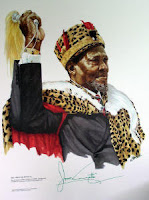
There are about 32 million people living in kenya at this time, and a numerous amount of tribes still surviving in their tropical climate. Kenya is very hot because the equator runs derictly through it. Kenya is the size of Nevada in the United States of America. English and Swahili are the languages taught throughout the country, but there are many other tribal languages. These include Kikuyu, Luhia, Luo and Kikamba as well as many other minor tribal tongues.
Kenyans love to party, and the music style known as benga is the contemporary dance music that rules. It originated among the Luo people of western Kenya and became popular in the area in the 1950s.Now in the late 1900, early 2000 Kenya's hip hop scene has really taken off. Only a few years ago, it was unthinkable for a Kenyan to earn any money, let alone earn a living from the trade. Well brace yourself, Kenya’s hip hop scene is among the most vibrant in Africa....and with a rapid rise in its popularity, both in Kenya and worldwide, this hip hop scene will only get better.
Traditionally, Kenya music centered on drumming and dance, often accompanied by humming, chatting and singing. Apart from the drums, other musical instruments include variations on flute, lyres and guitars, which may be seen in the National Museums of Kenya among their ethnic exhibits. Since then, Kenya music has evolved through early Afro-jazz to African hip-hop, rap and dance music. Recent years have seen an increase in FM radio stations throughout urban Kenya, and now Kenyan artists are at the forefront of the Kenyan music scene.
Kenyan cuisine generally consists of stodge filler with beans or a meat sauce. It's really just survival fodder for the locals maximum filling-up potential at minimum cost. If you had to name a national dish in Kenya, nyama choma (barbecued meat, usually goat), would probably be it. Kenyan food is not exactly designed for gourmet or vegetarians. Beer drinkers, on the other hand, are well supplied. Kenyans love their beer almost as much as their dancing and there's a thriving local brewing industry, and the Tusker beer is excellent. Kenya coffees are internationally renowned, and a major export. Local white wines from Naivasha are good. Local produce includes delicious mango and pawpaw, often served at breakfast. The Kenya coast has coral formations protected by law. Fishing for sport is highly popular, as is diving for pearls and lobster, sailing, and how voyages by moonlight.
Kenya clothing is varied as there are a number of tribes in Kenya. Each of the tribes of Kenya has their own dress and clothing culture that make them different and distinctive from each other. As such there is not a single dress that can be called to the identifying dress for the people of Kenya. Of late there has been an effort to make a national dress for the people of Kenya. But this dress has not become widely popular with general people. However, on a large scale, Kenya can boast of its varied way of dress and clothing done in several tribal communities2778 railroads km















